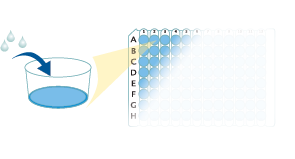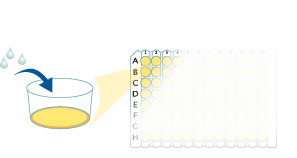Mouse CX3CL1/Fractalkine Quantikine ELISA Kit Summary
Product Summary
Precision
Cell Culture Supernates, Tissue Homogenates, Serum, EDTA Plasma, Heparin Plasma
| Intra-Assay Precision | Inter-Assay Precision | |||||
|---|---|---|---|---|---|---|
| Sample | 1 | 2 | 3 | 1 | 2 | 3 |
| n | 20 | 20 | 20 | 41 | 41 | 41 |
| Mean (pg/mL) | 1.9 | 5.2 | 18.6 | 1.4 | 5.5 | 20 |
| Standard Deviation | 0.19 | 0.42 | 1.7 | 0.17 | 0.31 | 0.92 |
| CV% | 10 | 8.1 | 9.1 | 12.1 | 5.6 | 4.6 |
Recovery
The recovery of mouse Fractalkine spiked to levels throughout the range of the assay in various matrices was evaluated.
| Sample Type | Average % Recovery | Range % |
|---|---|---|
| Cell Culture Supernates (n=5) | 101 | 94-106 |
| EDTA Plasma (n=6) | 95 | 83-109 |
| Heparin Plasma (n=6) | 95 | 81-110 |
| Serum (n=6) | 98 | 91-107 |
| Tissue Homogenates (n=1) | 100 | 100 |
Linearity
Scientific Data
Product Datasheets
Preparation and Storage
Background: CX3CL1/Fractalkine
CX3CL1/Fractalkine is a transmembrane adhesion protein with a chemokine domain separated from the membrane by a mucin stalk. It is upregulated on many cell types during inflammation. The chemokine and mucin regions can be shed as a soluble chemokine that signals through the receptor CX3CR1. During extravasation, membrane-bound CX3CL1 traps leukocytes, then is cleaved to allow diapedesis. Soluble CX3CL1 protects neurons from microglial neurotoxicity, recruits macrophages for wound healing, recruits osteoclast precursors for bone resorption, and contributes to pathogenesis in coronary artery disease.
Assay Procedure
Refer to the product- Prepare all reagents, standard dilutions, and samples as directed in the product insert.
- Remove excess microplate strips from the plate frame, return them to the foil pouch containing the desiccant pack, and reseal.
- Add 50 µL of Assay Diluent to each well.
- Add 50 µL of Standard, Control, or sample to each well. Cover with a plate sealer, and incubate at room temperature for 2 hours.
- Aspirate each well and wash, repeating the process 4 times for a total of 5 washes.
- Add 100 µL of Conjugate to each well. Cover with a new plate sealer, and incubate at room temperature for 2 hours.
- Aspirate and wash 5 times.
- Add 100 µL Substrate Solution to each well. Incubate at room temperature for 30 minutes. PROTECT FROM LIGHT.
- Add 100 µL of Stop Solution to each well. Read at 450 nm within 30 minutes. Set wavelength correction to 540 nm or 570 nm.





Citations for Mouse CX3CL1/Fractalkine Quantikine ELISA Kit
R&D Systems personnel manually curate a database that contains references using R&D Systems products. The data collected includes not only links to publications in PubMed, but also provides information about sample types, species, and experimental conditions.
12
Citations: Showing 1 - 10
Filter your results:
Filter by:
-
The miR-183/96/182 cluster regulates sensory innervation, resident myeloid cells and functions of the cornea through cell type-specific target genes
Authors: Gupta, N;Somayajulu, M;Gurdziel, K;LoGrasso, G;Aziz, H;Rosati, R;McClellan, S;Pitchaikannu, A;Santra, M;Shukkur, M;Stemmer, P;Hazlett, L;Xu, S;
Scientific reports
Species: Mouse
Sample Types: Tissue Homogenates
-
Modulation of inflammatory responses by fractalkine signaling in microglia
Authors: K Inoue, H Morimoto, M Ohgidani, T Ueki
PLoS ONE, 2021-05-21;16(5):e0252118.
Species: Mouse
Sample Types: Cell Culture Supernates
-
Peritoneal dialysate-range hypertonic glucose promotes T cell IL-17 production that induces mesothelial inflammation
Authors: A Helmke, AM Hüsing, S Gaedcke, N Brauns, MS Balzer, M Reinhardt, M Hiss, N Shushakova, D de Luca, I Prinz, H Haller, S von Vietin
Eur. J. Immunol., 2020-09-30;0(0):.
Species: Mouse
Sample Types: Cell Culture Supernates
-
Cathepsin S activation contributes to elevated CX3CL1 (fractalkine) levels in tears of a Sj�gren's syndrome murine model
Authors: R Fu, H Guo, S Janga, M Choi, W Klinngam, MC Edman, SF Hamm-Alvar
Sci Rep, 2020-01-29;10(1):1455.
Species: Mouse
Sample Types: Cell Culture Supernates
-
Sex differences in microglial CX3CR1 signalling determine obesity susceptibility in mice
Authors: MD Dorfman, JE Krull, JD Douglass, R Fasnacht, F Lara-Lince, TH Meek, X Shi, V Damian, HT Nguyen, ME Matsen, GJ Morton, JP Thaler
Nat Commun, 2017-02-22;8(0):14556.
Species: Mouse
Sample Types: Tissue Homogenates
-
Intravenous hMSCs Ameliorate Acute Pancreatitis in Mice via Secretion of Tumor Necrosis Factor-? Stimulated Gene/Protein 6
Sci Rep, 2016-12-05;6(0):38438.
Species: Mouse
Sample Types: Serum
-
Fibroblast growth factor receptor 1 activation in mammary tumor cells promotes macrophage recruitment in a CX3CL1-dependent manner.
Authors: Reed, Johanna, Stone, Matthew, Beadnell, Thomas C, Ryu, Yungil, Griffin, Timothy, Schwertfeger, Kathryn
PLoS ONE, 2012-09-24;7(9):e45877.
Species: Mouse
Sample Types: Cell Culture Supernates
-
Ozone inhalation promotes CX3CR1-dependent maturation of resident lung macrophages that limit oxidative stress and inflammation.
Authors: Tighe RM, Li Z, Potts EN, Frush S, Liu N, Gunn MD, Foster WM, Noble PW, Hollingsworth JW
J. Immunol., 2011-09-19;187(9):4800-8.
Species: Mouse
Sample Types: BALF
-
Essential involvement of CX3CR1-mediated signals in the bactericidal host defense during septic peritonitis.
Authors: Ishida Y, Hayashi T, Goto T, Kimura A, Akimoto S, Mukaida N, Kondo T
J. Immunol., 2008-09-15;181(6):4208-18.
Species: Mouse
Sample Types: Peritoneal Lavage Fluid
-
A novel mechanism for CCR4 in the regulation of macrophage activation in bleomycin-induced pulmonary fibrosis.
Authors: Trujillo G, O'Connor EC, Kunkel SL, Hogaboam CM
Am. J. Pathol., 2008-04-10;172(5):1209-21.
Species: Mouse
Sample Types: Tissue Homogenates
-
Down-regulation of surface fractalkine by RNA interference in B16 melanoma reduced tumor growth in mice.
Authors: Ren T, Chen Q, Tian Z, Wei H
Biochem. Biophys. Res. Commun., 2007-10-29;364(4):978-84.
Species: Mouse
Sample Types: Cell Culture Supernates
-
The arthritis severity quantitative trait loci Cia4 and Cia6 regulate neutrophil migration into inflammatory sites and levels of TNF-alpha and nitric oxide.
Authors: Laragione T, Yarlett NC, Brenner M, Mello A, Sherry B, Miller EJ, Metz CN, Gulko PS
J. Immunol., 2007-02-15;178(4):2344-51.
Species: Rat
Sample Types: Air Pouch Exudate
FAQs
No product specific FAQs exist for this product, however you may
View all ELISA FAQsReviews for Mouse CX3CL1/Fractalkine Quantikine ELISA Kit
Average Rating: 5 (Based on 1 Review)
Have you used Mouse CX3CL1/Fractalkine Quantikine ELISA Kit?
Submit a review and receive an Amazon gift card.
$25/€18/£15/$25CAN/¥75 Yuan/¥2500 Yen for a review with an image
$10/€7/£6/$10 CAD/¥70 Yuan/¥1110 Yen for a review without an image
Filter by:






